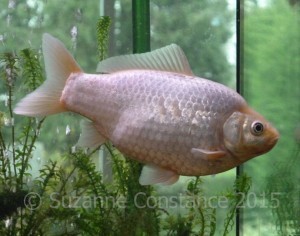Understanding the dietary needs of your goldfish is crucial for their health and longevity. As an experienced goldfish keeper, I’ve learned that providing the right food, in the right amounts, and at the appropriate intervals makes a significant difference in their wellbeing. Let’s dive into the specifics of goldfish nutrition.
Goldfish are often underfed due to the common misconception surrounding the mantra “do not overfeed.” While overfeeding can be detrimental, underfeeding is equally harmful. This advice frequently comes from needing to manage water quality in undersized tanks. In a suitably sized tank with proper maintenance, goldfish can enjoy a more generous diet. For more details on tank size and its impact on feeding, explore our article on Do fish grow to the size of their tank?
Goldfish Feeding Fundamentals: What and How?
Goldfish are omnivores, meaning they eat both plants and animals. While they’re not picky eaters, it’s vital to provide them with a balanced and nutritious diet.
Unlike humans, goldfish lack a stomach. Instead, they digest food as it moves through their intestines, extracting nutrients along the way.
Goldfish have pharyngeal teeth located at the back of their mouth. These teeth act as hard plates, grinding food before it’s swallowed. They’re also skilled sifters. They can take in mouthfuls of gravel, plants, and food, expertly separating edibles from inedibles before spitting out what they don’t want. You’ll often observe them sifting through the substrate, consuming food particles while expelling the gravel.
Goldfish also forage around their environment, seeking food caught in plants, decor, and even small snails or insects. Seeing them browse at the water’s surface isn’t cause for concern; they’re likely just looking for leftovers.
Dietary Needs: Singletail vs. Fancy Goldfish
Singletail goldfish generally possess more robust digestive systems compared to fancy goldfish. With more naturally shaped, torpedo-like bodies that are less affected by inbreeding, their internal organs are usually well-developed. This allows them to consume a wider variety of foods, including both floating and sinking options. Flake food typically poses no issue for them, although larger fish often favor pellets for a more substantial mouthful.
Fancy goldfish, on the other hand, often have more compact body shapes that can compromise their digestive systems. In these varieties, internal organs may be compressed or deformed, impacting their swim bladder and buoyancy. While not all fancy goldfish experience these issues, caution is advised.
Optimal Food Choices for Goldfish
Variety is key to a healthy goldfish diet. While singletail goldfish can handle a broader range of foods, this section focuses on recommendations suitable for fancy goldfish, which can also be applied to singletails.
Feeding Fancy Goldfish
Avoid flake food and prioritize high-quality sinking pellets. Sinking food helps prevent them from gulping air at the surface, which can lead to buoyancy problems.
Soak dry food for a minute or two before feeding. This allows the food to absorb water, preventing it from swelling in the fish’s digestive tract and causing indigestion or buoyancy issues.
Here are some food options to consider:
- Sinking Pellets: Tetra, Hikari, and Dainichi are popular brands among fancy goldfish keepers. Soak them in a cup of tank water before feeding.
- Frozen Foods: Defrosted bloodworms, brine shrimp, and daphnia are excellent options. Rinse them through a fish-only tea strainer after defrosting.
- Green Vegetables: Blanched broccoli florets, spinach (microwaved briefly until limp), blanched zucchini, and shelled, defrosted frozen peas provide essential nutrients. Spinach can be attached to the glass with a veggie clip, while broccoli and zucchini can be weighed down with a plant weight.
- Algae Wafers: Break them up and soak them well before feeding.
- Gel Food: Consider Repashy Soilent Green.
- Live Plants: Elodea is a great choice.
Explore tropical fish foods, comparing their protein content to that of goldfish food. While goldfish-specific food should be the staple, incorporating variety with tropical foods can be beneficial. Some goldfish enjoy bottom-feeder foods like earthworm pellets as occasional treats.
Feeding Frequency and Portion Sizes
Feed goldfish in the morning and evening, rather than one large daily meal. Dry food can be given in the morning, followed by vegetables or frozen food in the evening. Distribute the food around the tank to encourage foraging and prevent them from gulping it all down at once. Younger fish benefit from smaller, more frequent meals, while adult fish thrive on twice-daily feedings. Maintaining a supply of live plants allows them to snack throughout the day.
The amount of food is a balancing act. While some suggest feeding an amount equal to the size of the fish’s eye, this is often inadequate. Feed as much as they can consume in a couple of minutes, but don’t underestimate their appetite. Start with a generous pinch per fish and adjust as needed.
As a general guideline, adult goldfish (around 30cm long) can be given about a teaspoon of pellets, two or three algae wafers, a cube of frozen food, or four peas per fish per feeding. Adjust portions based on the size and age of your fish, and remember that a constant supply of live plants is beneficial.
Be prepared for goldfish to beg for food relentlessly. They are intelligent and will quickly learn that their behavior can result in feeding. Resist the urge to overfeed them, and instead focus on providing a balanced diet at regular intervals.
Monitor your fish’s waste. Translucent feces may indicate underfeeding, while excessive waste suggests overfeeding. Sluggishness after feeding also indicates potential overfeeding. Goldfish should be well-rounded; a skinny goldfish is an underfed goldfish.
Experiment with different vegetables and vary their diet to prevent boredom. Just like humans, goldfish appreciate a diverse menu.
